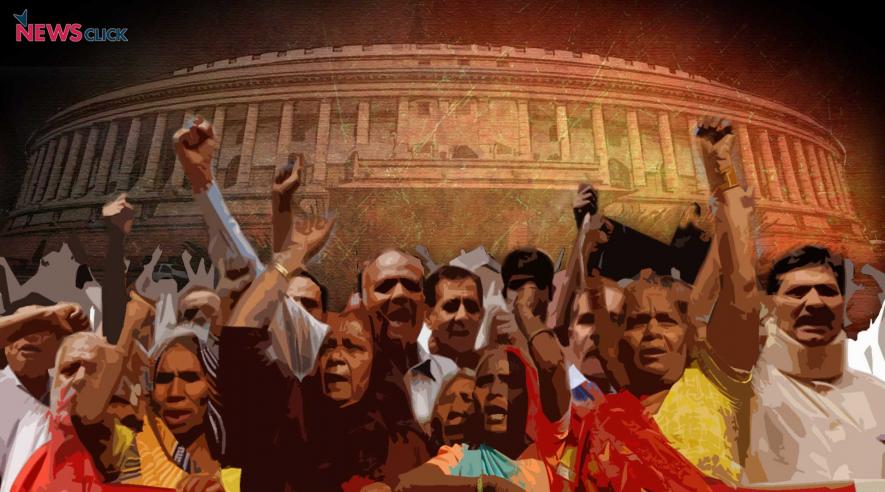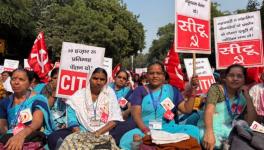Modi’s Crafty Games with Farmers and Workers

Surely it is not a coincidence that within a week of the mammoth protest rally of farmers and workers in Delhi, the Modi govt. made two announcements supposedly addressing their demands. One was the announcement of hike in payments made to anganwadi workers and helpers. The second was an umbrella scheme for ensuring better incomes for farmers. The announcements were hailed by the ruling BJP – and mainstream media - in superlative terms, with some even speculating that it would compensate for the four and half years of govt. indifference. Remember, all of Modi’s activities these days are geared towards the forthcoming Assembly and then, the Lok Sabha polls.
Let us look at the announcements in detail to see what exactly are they offering to India’s farmers, agricultural workers and other workers.
Farmers
The govt. has announced a grandly named Pradhan Mantri Annadata Aay Sanrakshan Abhiyan (PM-AASHA) which refers to farmers as “anna-daata” (food provider) and describes the scheme as ‘income protection campaign’. It has three components: Price Support Scheme (PSS), Price Deficiency Payment Scheme (PDPS) and pilot of Private Procurement & Stockist Scheme (PPSS). The govt. already runs a price support machinery under which minimum support prices (MSP) are announced for selected crops. A few more crops are to be included. So that’s nothing great.
The price deficiency payment part is a new scheme that was implemented by the BJP led Madhya Pradesh govt. in August 2017. It seeks to compensate farmers for the gap between what they get from the traders and the MSP. This idea came because farmers were not getting the MSP. The scheme looks attractive on the face of it but the experience of its implementation has brought out the deep flaws in it.
Farmers have reported that in MP, a modal price was introduced and the difference between this and the MSP was supposed to be given. What is this modal price? It is the average of the price prevailing in MP and two other top producing states. Usually, the modal price is much lower than the MSP. So, farmers were getting much lower compensation than expected.
Moreover, most farmers reported that they were not given the balance amount at all. They were chasing banks and govt. officials to no avail. Also, since there was a fixed period for selling the produce, cartels of traders were depressing prices in that period forcing farmers to sell at distress prices. There were also reports of traders themselves gobbling up the compensation by producing forged documents of purchase by farmers. As a result of all these shenanigans, in MP, the number of farmers enrolled in the scheme is sharply dropping off from the 20 lakh which had enrolled for the kharif marketing season last year. MP has an estimated 98 lakh farmers.
The third component of the new scheme is the most dangerous one – and it exposes the real intent of the govt. It is to be run as a pilot. It envisages roping in private traders to buy produce from farmers at MSP rates, with compensation to them (the traders) if prices fall below the MSP. The All India Kisan Sabha has described this as “facilitating corporate profiteering while washing its hands off procurement as well as public stockholding”. With paltry allocation for strengthening the public procurement system, the Modi govt. is actually handing over the existing procurement system to private traders and stockists through this new scheme. In fact this is in line with what the Shanta Kumar Committee had suggested and what the US and other advanced countries have been pressurising India to do.
Either way, farmers don’t get anything because the govt. has already given up on the Farmers’ Commission recommendation of cost price + 50%. Instead of full cost (C2) it has started using only A2+FL for its calculations although it keeps referring to it as cost price. A lie has been turned into a truth. So, with a reduced MSP, and with twists like the modal price, the govt. wriggles out of the responsibility of procurement and paves the way for private takeover of agricultural trade. This will spell doom for the country’s farmers and for consumers too.
Tenant Farmers and Agri-Workers
Completely ignored in this scheme – as in other such schemes of the Modi govt. – are two major sections involved in the agricultural economy. These are tenant farmers and agricultural labourers. The BJP govt. has not uttered a single word about the wages of agri-workers who represent the poorest and most oppressed section of the economy. Demands of raising the minimum wages or distributing land to the landless have fallen on deaf years. Tenant farmers will also get marginalised in all these schemes which require land holders’ registration etc.
Industrial & Service Sector Workers
Modi’s announcement of hike in payments to anganwadi workers and helpers will raise their earnings to - Rs.4500 pm for full anganwadi worker, Rs.3500 pm for mini-anganwadi worker and Rs.2250 pm for helpers. These workers are India’s frontline against rampant malnutrition, implementing the world’s largest infant and child nutrition programme, the ICDS. This programme itself has faced steady cuts in budgetary allocations under Modi’s rule. But that apart, to expect about 25 lakh women workers to work day and night for such meagre amounts is criminal. The reason why this system persists is because these workers are considered ‘volunteers’ who receive ‘honorarium’ not wages or salaries.
Modi govt. has refused to consider the demand – supported by the 45th Indian Labour Conference in 2013 – that anganwadi employees, and other ‘scheme workers’ (those employed in various govt. schemes) should be treated as regular employees with regular wages of at least Rs.18,000, social security and other benefits.
So, the sops offered by Modi in his announcement of hike are nowhere near what was expected and rightly demanded. Modi has not uttered a single word about other scheme workers like ASHAs (health workers numbering about 8 lakh) or mid-day meal cooks (some 25 lakh) and others all of whom are getting similar pittance of a wage.
But this is not all. Modi govt. has refused to even talk to trade unions about the long-standing demand for increasing the minimum wages of workers and employees to Rs.18,000 which is the absolute minimum required to keep a worker alive as computed by the Pay Commission.
In other words, all Modi and his neo-liberal advisers can think of in terms of responding to the growing anger amongst workers is a miserly increase for a tiny fraction of the total non-farm workforce of the country. Naturally, this move is bound to fail to win over any support from the workers in the forthcoming electoral battles. In fact, the workers are preparing to go on a two-day indefinite strike early next year to press for their demands.
Get the latest reports & analysis with people's perspective on Protests, movements & deep analytical videos, discussions of the current affairs in your Telegram app. Subscribe to NewsClick's Telegram channel & get Real-Time updates on stories, as they get published on our website.























